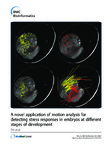A novel application of motion analysis for detecting stress responses in embryos at different stages of development.
| dc.contributor.author | Feistel, Susanne | |
| dc.contributor.author | Bitterli, T | |
| dc.contributor.author | Culverhouse, Phil | |
| dc.contributor.author | Spicer, John | |
| dc.contributor.author | Rundle, Simon | |
| dc.date.accessioned | 2016-10-07T14:12:19Z | |
| dc.date.available | 2016-10-07T14:12:19Z | |
| dc.date.issued | 2013 | |
| dc.identifier.issn | 1471-2105 | |
| dc.identifier.issn | 1471-2105 | |
| dc.identifier.other | 1 | |
| dc.identifier.uri | http://hdl.handle.net/10026.1/5710 | |
| dc.description | <28> This paper is an important evaluation of a new method invented and patented by Culverhouse (UK. PAT No. 1016616.3). The method offers a new way of monitoring environmental stresses and toxicities that is automatic, faster, and more objective than existing manual methods. This is the result of a long-standing collaboration with Rundle’s Developmental Biology lab at Plymouth. In this field, this technology significantly impacts the speed and efficiency of biology analyses. Ongoing plans for exploitation of this work and patent are in the field of commercial chemical screening opportunities with Astra Zeneca. | |
| dc.description.abstract |
Motion analysis is one of the tools available to biologists to extract biologically relevant information from image datasets and has been applied to a diverse range of organisms. The application of motion analysis during early development presents a challenge, as embryos often exhibit complex, subtle and diverse movement patterns. A method of motion analysis able to holistically quantify complex embryonic movements could be a powerful tool for fields such as toxicology and developmental biology to investigate whole organism stress responses. Here we assessed whether motion analysis could be used to distinguish the effects of stressors on three early developmental stages of each of three species: (i) the zebrafish Danio rerio (stages 19 h, 21.5 h and 33 h exposed to 1.5% ethanol and a salinity of 5); (ii) the African clawed toad Xenopus laevis (stages 24, 32 and 34 exposed to a salinity of 20); and iii) the pond snail Radix balthica (stages E3, E4, E6, E9 and E11 exposed to salinities of 5, 10 and 15). Image sequences were analysed using Sparse Optic Flow and the resultant frame-to-frame motion parameters were analysed using Discrete Fourier Transform to quantify the distribution of energy at different frequencies. This spectral frequency dataset was then used to construct a Bray-Curtis similarity matrix and differences in movement patterns between embryos in this matrix were tested for using ANOSIM. | |
| dc.format.extent | 37- | |
| dc.format.medium | Electronic | |
| dc.language | eng | |
| dc.language.iso | eng | |
| dc.publisher | Springer Science and Business Media LLC | |
| dc.subject | Motion analysis | |
| dc.subject | Bioimaging | |
| dc.subject | Toxicology | |
| dc.subject | Developmental stages | |
| dc.title | A novel application of motion analysis for detecting stress responses in embryos at different stages of development. | |
| dc.type | journal-article | |
| dc.type | Article | |
| plymouth.author-url | http://www.ncbi.nlm.nih.gov/pubmed/23374982 | |
| plymouth.issue | 1 | |
| plymouth.volume | 14 | |
| plymouth.publisher-url | http://www.biomedcentral.com/1471-2105/14/37 | |
| plymouth.publication-status | Published | |
| plymouth.journal | BMC Bioinformatics | |
| dc.identifier.doi | 10.1186/1471-2105-14-37 | |
| plymouth.organisational-group | /Plymouth | |
| plymouth.organisational-group | /Plymouth/Admin Group - REF | |
| plymouth.organisational-group | /Plymouth/Admin Group - REF/REF Admin Group - FoSE | |
| plymouth.organisational-group | /Plymouth/Faculty of Science and Engineering | |
| plymouth.organisational-group | /Plymouth/Faculty of Science and Engineering/School of Biological and Marine Sciences | |
| plymouth.organisational-group | /Plymouth/REF 2021 Researchers by UoA | |
| plymouth.organisational-group | /Plymouth/REF 2021 Researchers by UoA/UoA07 Earth Systems and Environmental Sciences | |
| plymouth.organisational-group | /Plymouth/Research Groups | |
| plymouth.organisational-group | /Plymouth/Research Groups/Marine Institute | |
| plymouth.organisational-group | /Plymouth/Users by role | |
| plymouth.organisational-group | /Plymouth/Users by role/Academics | |
| plymouth.organisational-group | /Plymouth/Users by role/Researchers in ResearchFish submission | |
| dc.publisher.place | England | |
| dcterms.dateAccepted | 2013-01-25 | |
| dc.identifier.eissn | 1471-2105 | |
| dc.rights.embargoperiod | Not known | |
| rioxxterms.versionofrecord | 10.1186/1471-2105-14-37 | |
| rioxxterms.licenseref.uri | http://www.rioxx.net/licenses/all-rights-reserved | |
| rioxxterms.type | Journal Article/Review |


